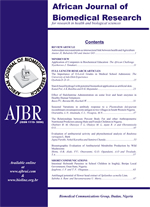
|
African Journal of Biomedical Research
Ibadan Biomedical Communications Group
ISSN: 1119-5096
Vol. 3, No. 3, 2000, pp. 133-137
|
 Bioline Code: md00041
Bioline Code: md00041
Full paper language: English
Document type: Research Article
Document available free of charge
|
|
|
African Journal of Biomedical Research, Vol. 3, No. 3, 2000, pp. 133-137
| en |
THE TOXIC EFFECTS OF PROLONGED ADMINISTRATION OF CHLORAMPHENICOL ON THE LIVER AND KIDNEY OF RATS
SABA A.B; OLA -DAVIES, O; OYEYEMI, M.O AND AJALA O.
Abstract
The toxic effect of chloramphenicol on the liver and kidney was studied in laboratory Wistar rats. 16 adult rats of both sexes randomly divided into two groups were used. 10 animals in the test group were administered with chloramphenicol orally using rat cannula at human infant recommended dosage of 25mg/kg body weight given once daily for a period of 16 days. The 6 animals in the control group were only administered with 0.9% physiological saline orally over the same period of time. Serum enzymes and levels of serum bilirubin, urea, and creatinine were evaluated to establish any hepatic or renal dysfunction. There was statistically significant increase in aspartate aminotransferase (P<0.05) and alanine aminotransferase (P<0.001) serum levels in the test animals. The increase in serum alkaline phosphatase was not statistically significant (P>0.05). Hyperbilirubinaemia was observed in the rat administered with chloramphenicol, the difference in the mean value of the test and control animals were significant for total and conjugated bilirubin. (Total bilirubin P<0.01; Conjugated bilirubin P<0.05). The average time taken to establish anaesthesia was shorter in the test animals than in animals in the control group, the difference in the mean values was significant (P<0.05). Serum urea and creatinine levels were elevated in the test animals, the increase is only statistically significant for serum urea (P<0.05) but not significant for creatinine (P>0.05). Histopathology revealed vascular congestion and foamy cytoplasm of hepatocytes at the centrilobular region of the liver but did not reveal any damage done to the renal tissue. It was concluded that chloramphenicol may not be nephrotoxic but may have toxic effects on the liver.
Keywords
Chloramphenicol, Toxic Effect, Rats.
|
| |
© Copyright 2000 - Ibadan Biomedical Communications Group
|
|
